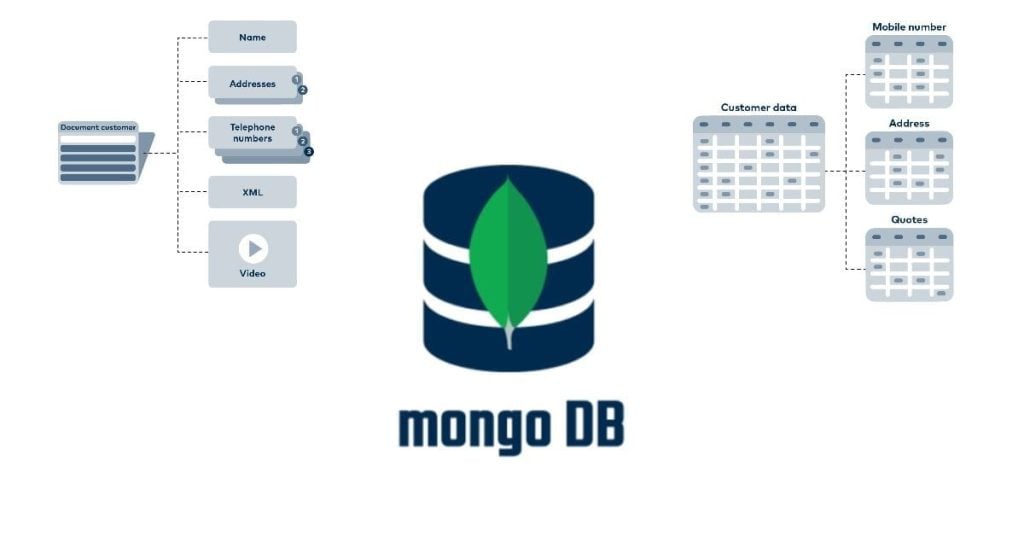The MongoDB is in traditional databases (SQL), it’s like arranging your toys in different boxes, shelves, and drawers, all labeled and organized. Each toy has its own place and they’re linked together in some way.
Now, with NoSQL databases, it’s more like having a big box where each toy is in its own bag. Each bag can hold different types of toys and has a label that tells you what’s inside. Instead of being neatly organized in separate places, everything is in these labeled bags, and you can easily see what’s in them. It’s like using a special kind of tag (JSON) that helps you quickly find and understand what’s in the bags.
The primary characteristics of MongoDB are:
1.Document-oriented model
Think of MongoDB as a tool made for creative builders (developers). It’s designed to be really flexible and help them work faster.
Instead of organizing data like pieces in a puzzle (using tables), MongoDB works more like a bunch of storybooks (documents). Each storybook (document) holds its own complete tale (data) and these storybooks are grouped together on a shelf (collection). This way, developers can focus on one story (document) at a time without needing to split it up or look in different places.
Now, MongoDB uses a special way to store these storybooks—it’s like a super-powered version of a language you might use every day (JSON). But this special version (BSON) can hold not just words but also cool things like videos, pictures, and text in a way that’s easy for the computer to understand. Plus, developers can talk to MongoDB using a specific tool (driver) that matches the language they’re using to build their projects.
2.Replication
Think of data like a treasure map that you want to keep safe. In regular databases, if the map is in one place and something bad happens there—like the map gets torn or the place gets blocked—you can’t find the treasure.
But MongoDB has a clever way to keep multiple copies of the map in different places (servers). So, even if something goes wrong with one place (server), you still have other maps safe and sound elsewhere. These copies are like having backups of the treasure map in case one gets lost or damaged.
Imagine these servers like a team working together. One of them is the main leader (primary server) who can update the map, while the others are ready to step up if the leader needs a break or can’t continue. If the main leader can’t work anymore, another one quickly takes charge to make sure everything keeps running smoothly. This way, there’s always someone in charge of the treasure map, making sure it’s safe and accessible.

3.Balance of load in MongoDB
Imagine a huge school with lots of students asking for help or borrowing books all day. To manage this properly, you’d want different librarians (servers) helping out, so no one gets overwhelmed.
Now, MongoDB is like having super-smart librarians who not only give out books (handle requests) but also make sure no one librarian gets too busy. They do this by sharing the work equally among themselves. So, if one librarian is really busy, others step in to help, making sure everyone gets what they need without anyone feeling swamped.
Usually, in a big library, you might need someone (a load balancer) to decide who goes to which librarian. But MongoDB is so clever that it manages this all by itself—like each librarian knowing exactly when to step up and help without needing someone to tell them what to do. This way, everyone gets their books (requests) on time, and no librarian has too much to handle.

4.Schema-less database
Imagine traditional databases like a set of boxes where you organize your toys. Each box is labeled and can only hold specific types of toys—one for dolls, one for cars, and so on. Everything has its own fixed place.
Now, with MongoDB, it’s like having a big box where you can throw in any toy you want, no specific compartments needed. You can have dolls, cars, and even some new toys all mixed together in this big box. It’s not picky about how the toys are shaped or what they’re made of.
This flexibility is cool because you can add new types of toys whenever you want without needing a new box. And here’s the best part: you can change how you organize these toys whenever you feel like it without causing a mess. It’s like being able to rearrange your toys without having to rebuild the whole toy chest!
Also, if you want to make sure only certain types of toys are allowed or that they follow certain rules (like no toys without wheels), MongoDB lets you set up these rules so that your toy collection stays tidy.
5.Sharding
Let’s imagine a big library with lots of books. Sometimes, there are so many books that they can’t all fit on one shelf. So, we create more shelves and put some books on each.
Now, in the world of databases like MongoDB, this idea is called sharding—it’s like having different shelves (shards) for different groups of books. Each shelf holds a part of the library’s collection.
When lots of people come to the library asking for books (queries), instead of one librarian searching through all the shelves, we have special helpers (Mongos) who know which shelf has which books. These helpers guide the people to the right shelf to find what they’re looking for.
Adding more shelves (shards) means we can fit more books and serve more people without anyone waiting too long. Each shelf (shard) works like its own mini-library, making sure everyone gets their books quickly and the library stays open all the time. This way, even with a huge number of books or visitors, everything runs smoothly and efficiently.
Conclusion
As you will observe, MongoDB is a huge success within the IT world. Learning how to use the database when creating applications and services will make you stand above the rest in your search for a new and possibly better job.
You can visit our site TechMe Today to get more tips. We hope this tips are helpful.



